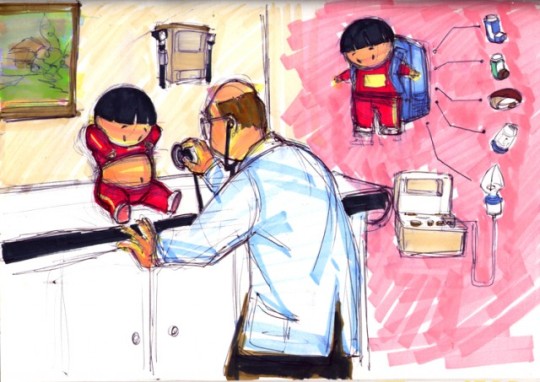
Montreal-based animator Jonathan Ng has done it all: co-create an innovative breakdance battle video game, Floor Kids, for Nintendo Switch; supply visual effects to major features like The Spiderwick Chronicles (2008); and animate his own stunning short films, including Requiem for Romance, above, which blew away festival audiences and earned its place on the Oscar-shortlist. This film took my breath away. A heart wrenching break-up call in the modern day interweaves with beautiful water and ink visuals of martial arts combat in feudal China; Requiem is an unprecedented piece of art. Watch it, then watch it again, then check out our conversation with Jonathan, below. And then maybe watch it one more time. I know I will.

How did you come to pursue animation?
It was a process, and it always came back to drawing. I don’t want to say I’ve been “drawing forever,” but I just never stopped. A teacher encouraged me to go to an arts high school. I was skeptical at first; I came from kind of a rough area in Toronto, and being artistic – being ambitious at all – was looked at strangely. But I fell in love with my arts school.
And then you went to college for art?
Traditional animation at Sheridan. And around the time that I was there, the industry was restructuring, with 3D, new techniques becoming more common. I didn’t feel like switching would be worth it, so I stayed focused on hand-drawn animation. I knew I’d be most satisfied with my work if I did. Over time, I’ve gained experience in those other areas as well.
How was it starting out as an independent animator?
Starting out was patchy. But I got by, trusted in the work, and things began falling into place.
Did you ever want to work at a large studio?
As a freelance animator I’ve had a hand in studio projects, mainly features, on a production by production basis. And being a guest at studios has satiated my curiosity; it’s sort of closed the loop for me on what might have been. There are upsides and downsides to working within a studio organization, and to working independently. But once you’re established as an independent filmmaker, there’s almost a mutual understanding between you and the studios, that you probably wouldn’t be a fit.
When did you first consider yourself a filmmaker?
In school, submitting work to festivals—that felt like preparation, an introduction to the world and the work required. But when I began working on my first film with the NFB – Asthma Tech – then, I was a filmmaker before I felt like one.

How has your experience been with the NFB?
It’s very competitive to receive funding, because so many artists are deserving. But if you do get to make a film, it’s an incredible opportunity. I do think that if you apply for funding and don’t get it, the best thing you can do is just make the thing anyway. Because if you’re at rock bottom, with no funding, no support, and you’re still making the work – you’re invincible at that point.
But competitive as it is, we’re very fortunate to have an organization like the NFB in Canada. It’s also a very supportive environment; everyone helps each other out on their films. There’s great work being done. While making Requiem, opportunities to contribute to other people’s films kept cropping up, and it became tough to balance. I wanted to do everything.
What inspired Requiem for Romance?
Story-wise, it was personal. I was seeing a girl, and she was also an artist. Both of us were inspired by water ink animations, which we were culturally connected to, because our families are from Shanghai. It wasn’t an art form that I learned in school, so it was a lot of independent exploration: researching the style, discovering the significance of different colors in ink drawings, learning the history of water and ink animation—which is fascinating, and intrinsically tied to China’s history with the Soviets. Throughout it all, I kept having, “How come I don’t know this?!” moments.
How is it, working with water and ink?
It’s very performative. I shot the water ink under a camera, so I really performed the splashes that you see in the film. It involved a lot of composition: of the direction, the speed and the movement of the ink. I treated the ink as if it were its own character.
Speaking of the characters – what inspired the combat elements of the film?
Growing up, I’d watch a lot of Teenage Mutant Ninja Turtles, Naruto—so I envisioned creating my own martial arts piece. That, too, led to more cultural exploration: I watched a lot of Chinese martial arts action films, primarily live action. I think Chinese kung fu exists most perfectly in an animated ink film, where it’s totally real within the world. No wires necessary.
So there were really three elements: martial arts action films, water and ink animation, and love stories. This is a hopelessly romantic breakup story, after all. For that, I turned to Chinese cinema too, watching a lot of the classics from Wong Kar Wai (In the Mood for Love, Happy Together).
Over email, you mentioned that it’s important to you that Requiem is re-watchable; why is that?
I definitely think short films are meant to be rewatchable. I don’t want the films I make to just roll by for people. There are things in Requiem, layers of meaning, that I expected only I would get—but I’ve been continually surprised by how much people pick up on. The use of distance, differences in fighting style, how the film is structured and designed for color, the way the water ink was controlled. The presence of choreographed movements that reflect the mood—a touchstone of 1980s Hong Kong martial arts films.
How was it taking Requiem around festivals?
It started off doing better at live action festivals. It was amazing how differently screenings could go; some, people would find it really funny, and others people would be crying at the end. Sometimes both. I did try to make it both funny and sad.
What did people tend to laugh out loud about?
Oh, man – the part where she tells him that they can’t both be artists because they’ll be poor. That got people.

But festivals are great, because you get to see the most amazing films. A lot of work that you’d just never have the opportunity to see otherwise. I’ve loved living in downtown Montreal, because the artistic community is so alive, everyone is doing their own thing; it’s impossible not to be swept up in it. There’s a festival just about every week here.
That sounds amazing. Your current project isn’t film though, right – it’s a video game?
Yeah, I just launched a game version of an idea that started as animated shorts, “Floor Kids”. In 2007 I partnered up with Kid Koala, a DJ and musician. We didn’t know what we’d make yet, but we knew we wanted to collaborate. That turned into the first “Floor Kids” short, and it went viral. And years later, it’s become a Nintendo Switch game. People have really come out for the game, it’s been an outpouring of support. It’s my first foray into gaming, and one of the most interdisciplinary art projects I’ve been a part of, combining game design, graphics, coding, art. The animation required about 1500 hand drawn frames per character, with 8 characters total, and hundreds of dance moves. The game coders had to design new systems, they were so unused to this much animation.
Being about hip hop dancing, and having this graffiti art style, did you draw inspiration for “Floor Kids” from your upbringing in Toronto?
Yeah – it’s grounded in street culture. Forms of expression like breakdance can draw people away from the worst of where they come from. My part of Toronto had this notorious, street-fighting reputation, that was only escalating as I got older. Going to an arts school was a shield, and it created an alternative for me and other kids.
There was a no-violence policy, so at a certain point, if you loved this stuff enough, you weren’t going to bother anyone. I remember once there was a goth kid who was being bullied by the jock-ish kids for how he dressed. The Vice Principal thought the solution was to punish him, and he ordered him not to wear dresses to school anymore. The next day, all the guys in the school wore dresses. And the kid was left alone after that.
And the area around my school was where all of the best graffiti artists would hit. It was incredible visual inspiration, but the administrators weren’t having it. They gave the taggers a truce: they could take a 3 story stairwell and do whatever they wanted on it, but nowhere else. You can imagine – it became a damn cool stairwell.
Thank you for the chat Jonathan! We’ll be on the look-out for your future projects.
– Cooper



